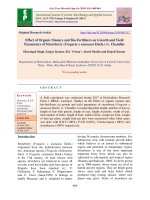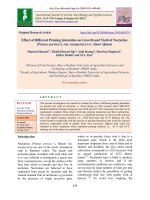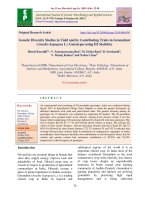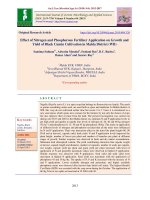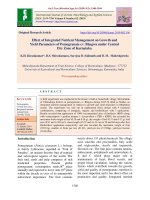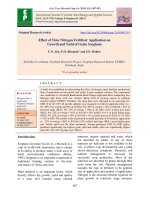Effect of sowing windows on growth and yield of groundnut (Arachis hypogaea L.) genotypes
Bạn đang xem bản rút gọn của tài liệu. Xem và tải ngay bản đầy đủ của tài liệu tại đây (238.14 KB, 9 trang )
Int.J.Curr.Microbiol.App.Sci (2019) 8(3): 59-67
International Journal of Current Microbiology and Applied Sciences
ISSN: 2319-7706 Volume 8 Number 03 (2019)
Journal homepage:
Original Research Article
/>
Effect of Sowing Windows on Growth and Yield of
Groundnut (Arachis hypogaea L.) Genotypes
K. Raagavalli*, T. M.Soumya, H.K. Veeranna, S.P. Nataraju and H. Narayanswamy
Department of Agronomy, College of Agriculture, University of Agricultural and
Horticultural Sciences, Shivamogga - 577204
*Corresponding author
ABSTRACT
Keywords
Groundnut, Growth
parameters, Yield,
genotype and
sowing windows
Article Info
Accepted:
04 February 2019
Available Online:
10 March 2019
In general groundnut (Arachis hypogaea L.) crop is subjected to varied climatic conditions
and monsoon vagaries in particular, as it is mostly grown under rainfed conditions during
Kharif. It is necessary to select a suitable groundnut genotype and sowing window as a
non-monetary input to reduce the effect of climate on crop yield. Field experiment was
conducted at AHRS, Bavikere, UAHS, Shivamogga, to study the influence of sowing
windows on growth and yield of groundnut genotypes under rainfed conditions during
Kharif-2017 in sandy loam soil. The four groundnut genotypes viz., GKVK-5, GPBD-4,
G2-52 and TMV-2 and four sowing windows viz., II fortnight of June, I fortnight of July,
II fortnight of July and I fortnight of August were selected. The experiment was laid out in
Randomized Complete Block Design with factorial concept using two factors, each with
four levels replicated thrice. The experimental results revealed that, the genotype GKVK-5
recorded significantly higher pod yield (16.73 q ha -1), shelling percentage and kernel yield.
While, the crop sown during II fortnight of June recorded significantly higher pod yield,
shelling percentage and kernel yield compared to delay in sowing. As delay in sowing
decreased the crop growth and development.
and development, thereby, reducing the pod
yield. Further, lack of moisture during
pegging and pod filling, reduces the number
of pods per plant, while that during pod
development produces shriveled seeds and
thereby, reduces the pod yield. Variation in
any of the weather parameter causes reduction
in the pod yield. Thus, it is necessary to grow
the genotype which can withstand weather
aberrations by adapting to varied sowing
windows. Nagaeswara Rao (1992) revealed
that improved genotypes contribute 25 to 28
per cent to the yield increase, while improved
Introduction
Groundnut is an important oilseed crop grown
under rainfed conditions. It is a very sensitive
crop to climatic variations, especially rainfall,
temperature and radiation (Banik et al., 2009).
As the crop is grown under rainfed
conditions, adequate soil moisture is required
during pegging and pod development stages,
to get better yield. Prathima et al., (2012)
reported that the photosynthetic activity of the
crop is severely affected under moisture stress
conditions, which reduces the crop growth
59
Int.J.Curr.Microbiol.App.Sci (2019) 8(3): 59-67
management practices contributed 30 to 32
per cent. Hence, an investigation was
conducted to study the influence of sowing
windows on growth and yield of groundnut
genotypes.
Results and Discussion
The weather parameters such as rainfall and
sunshine played a critical role on the crop
growth, which in turn decides the crop yield.
Apart from the total amount of rainfall
received, proper distribution of rainfall
throughout the crop growth period is also
important as seen in Figure 1. The crop
requires 400-500 mm of total rainfall. Among
the sowing windows, the crop sown during II
fortnight of June received 444.5 mm of total
rainfall, which was well distributed in 33
rainy days. Pod filling and pod development
stage, received (66 mm and 126.6 mm of
rainfall, respectively). The data pertaining to
the number of branches per plant, total dry
matter and CGR are presented in table 1. The
genotype GKVK-5 recorded significantly
higher number of branches per plant (10.40),
total dry matter (12.99 g plant-1) and CGR
(8.15 g m-2 day-1), which might be due to
better physio-morphological characters of
GKVK-5. Similar results were reported by
Mohite et al., (2017).
Materials and Methods
Field experiment was conducted at AHRS,
Bavikere, UAHS, Shivamogga during Kharif2017 under rainfed conditions. The soil of the
experimental site was sandy loam with acidic
pH (5.7), 1.73 g kg-1 organic carbon,
220.90:34.30:167.40 kg available N, P2O5,
K2O ha-1. The experiment was laid out in
randomized block Design with factorial
concept, containing sixteen treatment
combinations with three replications.
The groundnut genotypes and sowing
windows were the two factors, each with four
levels. The four genotypes selected were
GKVK-5, GPBD-4, G2-52 and TMV-2, while
the four sowing windows were II fortnight of
June, I fortnight of July, II fortnight of July
and I fortnight of August. Nutrients were
applied @ 25:50:25 kg NPK ha-1 in the form
of urea, SSP and MOP, respectively along
with 10 t of farm yard manure. Gypsum was
applied during the time of ear thing up @ 500
kg ha-1.
Among the sowing windows, thecrop sown
during II fortnight of June recorded
significantly higher number of branches per
plant (11.18), total dry matter (12.73 g plant-1)
and CGR (7.93 g m-2day-1). This might be due
to the proper distribution of rainfall during
critical growth period of the crop and long
day conditions exposed the crop to better
sunlight for longer duration which produce
more photosynthates and CGR for growth and
development of the plant, during early sown
conditions. Exposure of the crop to short day
conditions reduces the vegetative growth and
thereby reduces CGR (Meena et al., 2015).
Thus, the crop sown during I fortnight of
August recorded lower CGR (6.24 g m-2
day-1). Increase in the number of branches and
crop growth rate increased the total dry matter
per plant when the crop was sown during II
fortnight of June.
The seeds were sown at a depth of 5 cm with
30 x 15 cm spacing. The data on the
parameters like number of branches per plant,
leaf area (dm2 plant-1), total dry matter (g
plant-1), pod yield (q ha-1) and shelling
percentage were recorded and LAI, LAD,
CGR and kernel yield were calculated from
the recorded parameters. The amount of
rainfall received during the crop growth
period and water requirement of the crop at
different growth stages are presented in
Figure 1. The actual sunshine hours during
the crop growth period and the normal
sunshine hours of the research station is
presented in Figure 2.
60
Int.J.Curr.Microbiol.App.Sci (2019) 8(3): 59-67
Table.1 Influence of different sowing windows on number of branches, total dry matter and CGR of groundnut genotypes
Genotypes (G)
Sowing windows (S)
Number of branches (plant-1)
Total dry matter (g plant-1)
CGR (g m-2 day-1)
S1
S2
S3
S4
Mean
S1
S2
S3
S4
Mean
S1
S2
S3
S4
Mean
G1
11.87
10.83
10.53
8.37
10.40
14.76
13.55
12.06
11.60
12.99
9.41
8.57
7.47
7.16
8.15
G2
11.10
10.53
10.07
7.30
9.75
12.11
10.46
9.92
9.84
10.58
7.49
6.31
5.94
5.93
6.42
G3
11.40
10.77
10.27
7.80
10.06
13.09
12.07
11.40
10.38
11.73
8.20
7.49
7.03
6.31
7.26
G4
10.33
8.63
9.17
7.27
8.85
10.95
9.89
9.45
9.34
9.91
6.63
5.90
5.62
5.58
5.93
Mean
11.18
10.19
10.01
7.68
9.76
12.73
11.50
10.71
10.29
11.30
7.93
7.07
6.51
6.24
6.94
S.Em±
C.D. (p=0.05)
S.Em±
C.D. (p=0.05)
S.Em±
C.D. (p=0.05)
Genotypes
0.11
0.32
0.13
0.37
0.24
0.68
Sowing
0.11
0.32
0.13
0.37
0.24
0.68
0.22
0.64
0.25
0.74
0.47
1.36
windows
G×S
G1: GKVK-5
S1: II fortnight of June
G2: GPBD-4
S2: I fortnight of July
G3: G2-52
S3: II fortnight of July
G4: TMV-2
S4: I fortnight of August
DAS: Days after sowing
61
NS: Non-significant
Int.J.Curr.Microbiol.App.Sci (2019) 8(3): 59-67
Table.2 Influence of different sowing windows on leaf area, LAI and LAD of groundnut genotypes
Genotypes (G)
Sowing windows (S)
Leaf area (dm2 plant-1)
LAI
LAD (days)
S1
S2
S3
S4
Mean
S1
S2
S3
S4
Mean
S1
S2
S3
S4
Mean
G1
9.27
8.81
8.78
8.52
8.85
2.06
1.96
1.95
1.89
1.97
63.87
60.38
60.00
57.49
60.43
G2
9.10
8.54
7.91
7.88
8.36
2.02
1.90
1.76
1.75
1.86
61.08
57.09
54.08
53.40
56.41
G3
9.17
8.74
8.45
7.99
8.59
2.04
1.94
1.88
1.78
1.91
62.83
59.63
58.08
55.29
58.96
G4
8.91
8.44
7.98
7.27
8.15
1.98
1.88
1.77
1.62
1.81
59.62
56.00
53.33
50.83
54.95
Mean
9.11
8.63
8.28
7.92
8.49
2.02
1.92
1.84
1.76
1.89
61.85
58.27
56.37
54.25
57.69
S.Em±
C.D. (p=0.05)
S.Em±
C.D. (p=0.05)
S.Em±
C.D. (p=0.05)
Genotypes
0.07
0.19
0.01
0.04
0.59
1.72
Sowing
0.07
0.19
0.01
0.04
0.59
1.72
0.13
0.39
0.03
0.09
1.19
3.43
windows
G×S
G1: GKVK-5
S1: II fortnight of June
G2: GPBD-4
S2: I fortnight of July
G3: G2-52
S3: II fortnight of July
G4: TMV-2
S4: I fortnight of August
DAS: Days after sowing
62
NS: Non-significant
Int.J.Curr.Microbiol.App.Sci (2019) 8(3): 59-67
Table.3 Influence of different sowing windows on pod number per plant, shelling per cent and kernel yield of groundnut genotypes
Genotypes (G)
Sowing windows (S)
Pod number per plant
Kernel yield (q ha-1)
Shelling per cent
S1
S2
S3
S4
Mean
S1
S2
S3
S4
Mean
S1
S2
S3
S4
Mean
G1
12.39
12.32
10.95
10.23
11.47
74.00
73.33
72.60
70.67
72.65
13.37
13.18
11.59
10.54
12.17
G2
11.59
10.25
8.88
7.71
9.61
73.33
72.33
71.33
63.00
70.00
10.99
9.58
8.18
6.28
8.76
G3
14.43
13.97
13.37
11.59
13.34
73.00
72.00
69.33
68.33
70.67
11.81
11.06
9.52
8.13
10.13
G4
8.55
7.93
7.45
7.00
7.73
72.27
71.67
70.33
61.33
68.90
8.37
7.70
7.10
5.82
7.25
Mean
11.74
11.12
10.16
9.13
10.54
73.15
72.33
70.90
65.83
70.55
11.13
10.38
9.10
7.69
9.58
S.Em±
C.D. (p=0.05)
S.Em±
C.D. (p=0.05)
S.Em±
C.D. (p=0.05)
Genotypes
0.19
0.55
0.80
2.31
0.14
0.40
Sowing
0.19
0.55
0.80
2.31
0.14
0.40
0.38
1.09
1.60
NS
0.28
0.80
windows
G×S
G1: GKVK-5
S1: II fortnight of June
G2: GPBD-4
S2: I fortnight of July
G3: G2-52
S3: II fortnight of July
G4: TMV-2
S4: I fortnight of August
DAS: Days after sowing
63
NS: Non-significant
Int.J.Curr.Microbiol.App.Sci (2019) 8(3): 59-67
Fig.1 Water required by the crop and the amount of rainfall received during different crop
growth stages
Fig.2 Actual and normal sunshine hours during the crop growth period
Fig.3 Influence of different sowing windows on pod yield of groundnut genotypes
64
Int.J.Curr.Microbiol.App.Sci (2019) 8(3): 59-67
With the delay in sowing, the number of
branches, total dry matter and CGR decreased
during I fortnight of July, II fortnight of July
and lowest during I fortnight of August. This
was due to the moisture stress during late
sown conditions. Prathima et al., (2012)
stated that the crop growth reduces due to
water stress, which reduces the assimilates of
photosynthates.
GKVK-5 sown during II fortnight of June
recorded higher number of branches (11.87
plant-1), total dry matter (14.76 g plant-1) and
CGR (9.41 g m-2 day-1) compared to other
treatment combinations. This might be due to
the combination of genetic character and also
the optimum weather conditions during the
crop growth. Similar results were reported by
Mohite et al., (2017).
The interaction effect of genotypes and
sowing windows revealed that the genotype
GKVK-5 (8.85 dm2 plant-1 and 1.97,
respectively) this was followed by G2-52
(8.59 dm2 plant-1 and 1.91, respectively),
GPBD-4 (8.36 dm2 plant-1 and 1.86,
respectively) and TMV-2 (8.15 dm2 plant-1
and 1.81, respectively). Increase in the leaf
area was due to increase in number of
branches, which increases the number of
leaves per plant. Bhargavi et al., (2016)
reported similar results with different spacing
treatments in groundnut and stated that
increase in the number of leaves increases the
leaf area. Increase in the leaf area increases
LAI, which further increases LAD, where the
genotype GKVK-5 recorded significantly
higher LAD (60.43 days), which was on par
with G2-52(58.96 days) (Table 2).
Significantly higher leaf area and LAI (Table
2) were recorded in the genotype
the leaf area, as the plant cannot intercept
more radiations due to short-day conditions
and thereby, reduces the LAI and LAD.
Agarwal et al., (1996) and Kumar et al.,
(2011) in niger crop reported that delay in
sowing reduces the duration of vegetative
growth, thereby, producing less number of
leaves per plant and thus, decreased leaf area
due to soil moisture stress than the early sown
crop. The genotype GKVK-5 sown during II
fortnight of June recorded higher leaf area
(9.27 dm2 plant-1), LAI (2.06) and (63.87
days) compared to other treatment
combinations.
Pod yield (Fig. 3) was found to be
significantly higher in the genotype GKVK-5
(16.73 q ha-1) compared to G2-52 (14.29 q
ha-1), GPBD-4 (12.42 q ha-1) and TMV- 2
(10.48 q ha-1). Increase in the pod yield was
due to increase in the growth parameters viz.,
number of branches, total dry matter, CGR,
leaf area, LAI and LAD. Increase in the
growth
parameter
provides
better
translocation of photosynthates to the sink
and thereby, increases the pod yield. Thus,
variation in the growth parameters varies the
pod yield between the genotypes. Mohite et
al., (2017) and Naik et al., (2018) also
obtained similar results.
The crop sown during II fortnight of June
recorded significantly higher leaf area, LAI
and LAD (9.11 dm2 plant-1, 2.02 and 61.85
days, respectively) (Table 2). This was
followed by the crop sown during I fortnight
of July (8.63 dm2 plant-1, 1.92 and 58.27 days,
respectively), II fortnight of July (8.28 dm2
plant-1, 1.84 and 56.37 days, respectively).
Delay in sowing reduced the leaf area, LAI
and LAD. This might be due to the stressed
condition on the plant with delay in sowing,
caused by lack of rainfall which decreased
from 444.5 mm during II fortnight of June to
236.2 mm during I fortnight of August. The
vegetative growth reduces as the days become
shorted with delayed sowing. This reduced
The pod yield decreased to 59.63 per plant
with delay in sowing from II fortnight of June
to I fortnight of August. The crop sown
65
Int.J.Curr.Microbiol.App.Sci (2019) 8(3): 59-67
during II fortnight of June recorded
significantly higher pod yield (15.20 q ha-1),
which was due to favorable weather
conditions prevailed during crop growth
period and similar findings were reported by
Canavar and Kaynak (2008) and Bala et al.,
(2011). Chandrika et al., (2008) reported that
the effect of rainfall was greater on vegetative
growth of the crop under late sown
conditions. Canavar and Kynak (2010) also
opined that short- day conditions reduces the
crop growth period and unsuitable conditions
like lack of rainfall under delayed sowing are
unfavourable to the crop growth due to
stressed conditions and thereby, reduces the
pod yield. Early sowing of groundnut rarely
experiences
moisture
stress
during
reproductive
stage,
especially
pod
development stage under normal rainfall
distribution and was found to be more
beneficial compared to delayed sowing (Patel
et al., 2013).
compared to delayed sowing (I fortnight of
August). The genotype GKVK-5 was found to
perform better compared to G2-52, GPBD-4
and TMV-2, which produced higher pod
yield, due to its genotypic characteristics
References
Agarwal, K. K., Jain, K. K., Sharma, R. Sand
Kashyad, N. L. 1996. Response of
winter niger (Guizotia abyssinia) to
sowing time and fertility levels.
Oilseeds Research. 13: 122-123.
Bala, H. M. B., Ogunlela, V. B., Kuchinda, N.
C and Tanimu, B. 2011. Response of
two groundnut (Arachis hypogaea L.)
varieties to sowing date and NPK
fertilizer rate I a semi- arid
environment:
Yield
and
yield
attributes. Asian Journal of Crop
Science. 3: 130-140.
Banik, N. C., Nath, R and Chakraborty, P. K.
2009. Effect of dates of sowing on
growth and yield of groundnut
crop.Journal of Crop Weed. 5: 59-62.
Bhargavi, H., Srinivasa Reddy, M., Tirumala
Reddy, S., Kavitha, P., VijayaBhaskra
Reddy, V and Ramesh Babu, P. V.
2016. Productivity of groundnut
(Arachis hypogea L.) as influenced by
varieties and plant densities. Journal
of Oilseeds Research. 33: 83-86.
Canavar, O and Kaynak, M. A. 2008. Effect
of different planting dates on yield and
yield components of groundnut
(Arachis hypogea L.). Turk Journal of
Agriculture. 32: 521-528.
Canavar, O and Kaynak, M. A.2010.Growing
degree day and sunshine radiation
effects on peanut pod yield and
growth.
African
Journal
of
Biotechnology. 9: 2234-2241.
Chandrika, V., Parameshwari, P and
Sreenivas, G. 2008. Effect of sowing
time and rainfall distribution on yield
of rainfed groundnut (Arachis
Kernel yield depends on the pod yield and
shelling per cent. Significantly higher kernel
yield was recorded in the genotype GKVK-5
(12.17 q ha-1) (Table 3) due to better shelling
per cent (72.65). However, higher number of
pods per plant was observed in G2-52 (13.34)
and lower in TMV-2 (7.73). This might be
due to the genetic characteristic of the
genotype (Mohite et al., 2017).
Kernel yield was found significantly higher
when the crop was sown during II fortnight of
June (11.93 q ha-1) (Table 3) than delayed
sowing during I fortnight of August (7.69 q
ha-1). This was due to the higher pod yield
and shelling per cent.
Thus, it can be concluded that, the early
sowing (II fortnight of June) can produce
higher pod yield due to better vegetative
growth, which can translocate photosynthates
to the sink and can escape moisture stress
conditions during critical growth period,
66
Int.J.Curr.Microbiol.App.Sci (2019) 8(3): 59-67
hypogeal L.) in southern agroclimatic
zone
of
Andhra
Pradesh.Legume Research. 31: 54-56.
Kumar,
B.
N.
M.,
Basavegowda,
Vyakaranahal, B. S., Deshpande, V. K
and Kenchanagowdar, P. V.2011.
Influence of sowing dates on
production of seed yield in niger
(Guizotia
abyssinia).
Karnataka
Journal of Agricultural Sciences. 24:
289-293.
Mohite, U. A., Mohite, A. B and Jadhav, Y.
R. 2017. Effect of sowing windows on
growth and yield of groundnut
varieties during Kharif season.
Contemporary Research in India. 7:
189-192.
Nagaeswara Rao. 1992. Some crop
physiological
approaches
for
groundnut improvement. Journal of
Oilseeds Research. 9: 281-296.
Naik, A. H. K., Pallavi, N and
Sannathimmappa, H. G. 2018.
Performance of different SpanishType groundnut varieties suitable
under Central dry zone of Karnataka,
India. International Journal of Current
Microbiology and Applied Sciences.
7: 1394-1397.
Patel, H. R., Lunagaria, M. M., Krande, B. I.,
Vyas Pandey., Yadav, S. B., Shah,
A.V., Rao, V. U. M and Nareshkumar,
S. 2013. Impact of projected climate
change on groundnut in Gujarat.
Journal of Agrometeorology. 15: 1-4.
How to cite this article:
Raagavalli, K., T. M.Soumya, H.K. Veeranna, S.P. Nataraju and Narayanswamy, H. 2019.
Effect of Sowing Windows on Growth and Yield of Groundnut (Arachis hypogaea L.)
Genotypes. Int.J.Curr.Microbiol.App.Sci. 8(03): 59-67.
doi: />
67
